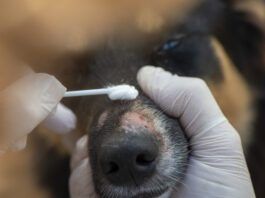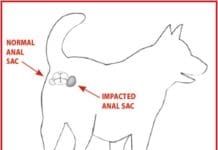Parvo Victim # 2
The name Ray Carlisle is synonymous with Doberman Pinschers. A breeder and exhibitor for 40 years, a show judge for the last 20 years, and a former president of the Doberman Pinscher Club of America, the United Doberman Club, and the American Working Dog Federation, the New York resident travels the world on behalf of his favorite breed. I vaccinated my dogs for many years
The Scooting Dog Decoded
Why is Rover dragging his butt across the carpet? Not just annoying to watch, this behavior is usually indicative of a bigger problem - infected or impacted anal sacs. Also called anal glands, these little pouches are found on several different mammals including dogs and cats, and are not very noticeable when healthy. When they are clogged or infected, however, your dog will MAKE you notice them.
How to Tell If Your Dog Has Hip Dysplasia
My six-month-old Rottweiler has a goofy, bouncy walk. Does that mean she has hip dysplasia?A lot of puppies especially big, gangly ones have a clumsy, bumbling gait, and this does not mean they have hip dysplasia. If your puppy had a hip dysplasia, you might notice that she limps sometimes, especially after strenuous exercise. You might hear or feel her hips click in and out, or notice that she stands and walks with her hocks or hind feet very close together. You might notice her struggling to push herself up into a standing position when shes lying down, or she might have trouble climbing stairs.
What To Do If Your Dog Has Worms
Deworming agents are present in any number of prescription and over-the-counter treatments for dogs and puppies. If your dog shows signs of a gastrointestinal worm infestation, there are all sorts of products available that are made exclusively to rid dogs of various types of worms. But there are also deworming agents included whether they are needed or not in many flea and tick treatments and in most heartworm preventive drugs; in fact, it's sometimes hard to find a minimalist flea treatment or heartworm preventive drug that does not contain dewormers. The question is, is this really necessary? Are intestinal parasites that much of an ongoing threat to most dogs and their owners?
Home Treatment for Parvo May Prevent “Economic Euthanasia”
When experienced breeder Barbara Sorg noticed that Winks, one of her five 8-week-old puppies, was listless, not eating, and by nightfall was suffering from diarrhea, she hustled him off to her long-time veterinarian the next morning, a Tuesday.??The vet suspected that Winks had not tolerated the dewormer he'd been given Sunday. Although he had never left her property and had no suspected exposure, Sorg asked that he be tested for deadly parvovirus; her veterinarian discounted the possibility.
An Old Infectious Disease Is New Again
It’s baaaaack. News that infectious canine hepatitis surfaced in New England this summer is not exactly on par with the possessed television sets and otherworldly bedroom-closet portals in the 1980s horror flick “Poltergeist.” But the fact that the disease – formally known as canine adenovirus-1, or CAV-1 – has materialized in the United States is likely to induce goosebumps in those who have opted to not vaccinate against it, thinking it was essentially obliterated in the American dog population.
Properly Diagnosing Canine Hypothyroidism – What are the Signs?
You probably know someone with an underactive thyroid gland; in fact, you may have one yourself. The signs of hypothyroidism in humans include a subnormal body temperature, cold hands and feet, weight gain, hair loss, and constant fatigue. People aren’t the only ones afflicted by this disorder, for many dogs are hypothyroid, too. They may seem lethargic, gain weight while eating normal or below-normal amounts of food, seek warmth, and develop skin and coat conditions. But hypothyroidism causes other symptoms, too, and an accurate diagnosis can require thinking outside the box.
Help Manage Your Dog’s Diabetes Through Proper Diet
There is no single “best” diet for dogs with diabetes. Most diabetic dogs do fine on a diet formulated for adult maintenance. And most do not require a high-fiber prescription diet. However, it is important to maintain consistent carbohydrate levels, and a diet moderately low in fat may be safest. The nutritional needs of any concurrent disease should take precedence.Dogs with diabetes can thrive on diets that are dry or canned, prescription, frozen raw, home-prepared (cooked or raw), and combinations of any of these. See the samples below (starting with “Prescription Diets”) for a variety of diets that have worked well for diabetic dogs and their caregivers. We’ll say it again: There is no single “best” diet for dogs with diabetes. Most diabetic dogs do fine on a diet formulated for adult maintenance. And most do not require a high-fiber prescription diet.
Hazards of Hypoglycemia (Low Blood Sugar)
Hypoglycemia is a serious risk factor in diabetes management. Recent studies suggest that approximately 10 percent of diabetic dogs experienced hypoglycemic episodes that required hospitalization. One large survey found that the majority of diabetic dogs presented for hypoglycemia were receiving high doses of insulin (0.7 units or more per pound of body weight).
Managing Diabetes in Dogs
What causes diabetes in dogs? Diabetes is one of the most common endocrine diseases affecting middle-aged and senior dogs, with 70 percent of patients older than seven at the time of diagnosis. Diabetes in puppies hardly exists - diabetes rarely occurs in dogs younger than one year of age, and it is more common in females and neutered males than in intact males. Keeshonds, Pulis, Cairn Terriers, Miniature Pinschers, Poodles, Samoyeds, Australian Terriers, Schnauzers, Spitz, Fox Terriers, Bichon Frise, and Siberian Huskies may be at higher risk.
Causes of Canine Conjunctivitis and Treatment Options
Something is wrong with your dog’s eye. It’s bright red or oozing pus or itching like crazy. Could it be pink eye? This common childhood condition, also known as red eye or conjunctivitis, affects people, cats, and our canine companions. Conjunctivitis is an inflammation of the conjunctiva, the tissue covering the eye and inner surface of the eyelid. If caused by bacteria or viruses, it can be infectious. Noninfectious conjunctivitis can be caused by allergic reactions, irritants, or trauma injuries.
Clarifying Diagnosis of Addison’s Disease; Excellent New Book
The October and November 2011 issues of Whole Dog Journal provided in-depth discussion of canine Addison’s and Cushing’s diseases. The following information should help clarify other questions that may arise about the diagnosis of canine adrenal disorders. The relationships between adrenal cortisol and sex steroid production is complicated. In chronic illnesses, the body’s adrenal glands can become exhausted or fatigued. The adrenal glands may then respond by increasing the output of cortisol, and the intermediate and sex steroids.



















